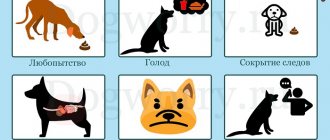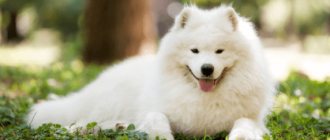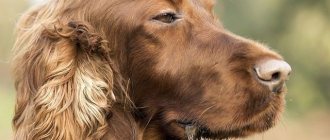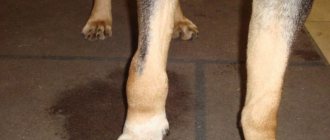Humanity has farted 17 quadrillion times throughout history.
The average person farts 14 times a day. The Deadspin publication was not too lazy to count how many times the entire population of the planet farted in this case. We know approximately how long we have inhabited the Earth, we know how many years we live on average, and we know how many of us there are. This allows us to make a rough calculation. That comes out to an astonishing figure of 17 quadrillion farts.
ILLUSTRATION: PIRO4D / PIXABAY / FAKTRUM
How to stop an adult dog from chasing cats
It is not as easy to train adult dogs to chase cats as it is to train puppies, so be patient. You can use the same methods as for puppies. If you adopted an adult dog from a shelter and it is not obedient and has good manners, contact a dog trainer for help. Follow all the specialist’s recommendations, consolidate the skills acquired on the training ground at home and on walks. Over time, thanks to systematic training, the dog will wean itself from harmful manners and bad habits.
- Correct behavior with encouragement and reprimand. If the dog reacts sharply to cats or other animals, be strict and ensure that the commands “Come”, “Fu”, “No” are followed. Dogs should immediately come to you when called, despite the presence of external stimuli. If your long-distance pet shows no interest in cats, always praise, pet him and reward him with treats.
Important! Don't scold your pet for being incontinent. A prohibition only fuels interest, and if physical force is used in addition to reprimand, the dog may spite you.
- Learn how to behave properly with a dog. Try to completely refuse rewards and every time the dog shows disobedience or is about to start a hunt for a moving object, scold the dog in a stern tone and lightly slap him on the butt. You can also use sounds that are unpleasant to the dog's ears, for example, Fischer discs.
- If the dog is uncontrollable and cannot suppress its hunting instinct, keep the dog on a strict collar. One strong impact is better than constant tugging on the collar.
- You can use special devices, for example, ultrasound, electrical impulse. The last option is very effective and efficient, but quite painful for dogs.
One kiss transfers more than 80 million bacteria from mouth to mouth
People need to replenish their “collection” of bacteria, since it is on the cells of these bacteria that our immune cells conduct “training,” “training” new cells to recognize and repel bacterial attacks. We get them in the process of eating, touching various objects and interacting with other people, including through kissing.
Photo: Denys Kovtun / Depositphotos
Why do dogs chase cats?
To stop your dog from chasing cats on the street, be patient. This habit is inherent in nature, especially among representatives of hunting breeds. Dogs, experiencing the hunting instinct, simply cannot resist it.
Unfortunately, it will take more time to wean an adult dog from this harmful habit, so it is worth properly socializing your pet and instilling useful behavioral skills in it at an early age.
Important! A dog, regardless of age and breed, must unquestioningly follow commands, which is achieved through systematic exercise and training.
At home and on the street, the dog must behave well, react adequately to relatives and other animals, so as not to cause problems for the owner and people around him. When chasing a cat, it is almost impossible to control the dog. Carried away and succumbing to the hunting instinct, the dog rushes headlong after his “prey.” For him, nothing and no one around exists. Just a cat running away.
- In this way, dogs assert themselves and increase their self-esteem. By chasing the “victim”, the dog shows dominance, shows its strength and advantage.
- Representatives of hunting breeds chase cats for fun. For example, terriers, setters, spaniels, sighthounds, hounds, and greyhounds react sharply not only to cats, but also to any moving objects.
- Dogs' dislike of cats can also be caused by a puppy or adult dog being scratched by a cat or a cat guarding its offspring or territory. Dogs remember their offenders for a long time, study their behavior, and at any opportunity, sooner or later they will take revenge. Only a completely innocent animal, or worse, a small defenseless kitten, can suffer.
Do dogs and cats fight?
Childhood experience is reinforced by the demonstration of dogs' hostility towards cats. It's hard not to believe that cats and dogs are at odds with each other when the dog chases a purr across rough terrain to the nearest tree. Everyone probably saw the scene of the chase, but did you watch what happens after? As soon as the cat climbs the tree, it calms down, calmly watches the dog, washes itself, and can even go to bed. The dog jumps near the tree for several minutes and loses interest in the cat.
What are the reasons for this animal behavior? Let us immediately note that we are not talking about enmity, hatred or dislike in the literal sense. The fact that cats and dogs do not naturally quarrel can be judged by the numerous cases of friendship between these animals . A lot of strange unions have happened in the four-legged world: predators were friends with prey, cats fed hedgehogs, chickens took care of kittens... against their background, a dog being friends with a cat is a common phenomenon.
In one of the pet magazines, the relationships of pets of different species were described. The story was about a cat, a dog and a parrot. This trio was not just friends, they established a kind of cooperation. When the owners were not at home, or even in their presence, friends resorted to various tricks to get tasty treats. The parrot “unnoticed” dropped tidbits from the table, and the cat and dog picked them up on the floor. The cat opened the cabinet doors, and the dog was on duty at the entrance to warn his accomplices. The story described looked very incredible, but the words of the owners were confirmed by photographs of some of the tricks.
Not long ago, the World Wide Web was hit by a viral video about the role of a cat in the fate of a puppy. The baby fell into a hole and could not get out. An adult cat walked by and found a puppy in trouble. Purr took a long time to make a decision and watched the dog in trouble. As a result , the cat jumped into the hole and pulled out the puppy. It’s not entirely appropriate to talk about friendship here, but the assumption of innate interspecies love is once again debunked.
Domesticated cats and dogs have successful relationships. Pets may not be friends, but they can successfully coexist in the same territory. Truly amazing examples of warm relationships between cats and dogs are always associated with survival. For food and warmth, street dogs and cats often form groups, especially in winter.
The following story was not captured on video, but became no less famous. Major media outlets published an essay about the life of a group of Central Asian shepherd dogs, into whose ranks a kitten found its way. The events took place in the homeland of dogs, where, to put it mildly, they do not take special care of the animals. How the little kitten ended up with such serious dogs is unknown. The story told about the development of events. The fact is that the kitten could not eat normally due to its age and was fed by a female Central Asian Shepherd who had puppies at that time. The new member of the pack was not touched by the males or other females. It seems that animals follow the principle “there are no other people’s children” and... do it much more successfully than people.
Readers assumed that the lactating bitch did not distinguish the kitten from her puppies, but is this possible? A newborn CAO puppy weighs 4–5 times more than a kitten. The reasons for the dogs’ behavior have not been established, but one thing is clear: another gap has appeared in the theory of innate hatred of cats.
Instinctive experience in cats and dogs
When a puppy first appears in the house, he hurries to explore every corner, diligently sniffing everything in his path. Curiosity completely erases fears. And even a small kitten is in no hurry to move through unfamiliar territory, carefully studying the close space surrounding it.
Caution is in the blood of cats
Seeing a cat on the street, the dog immediately rushes to meet a new potential friend. And if a frightened cat hits him in a vulnerable place (for example, on the nose), then the dog will forever remember such a sad and painful experience. It's not hard to guess how he will treat any cat the next time he meets.
It is believed that the distant predecessors of cats were large saber-toothed tigers and lions . They gratified their pride by annoying small wolves and jackals. The canine squad has learned to dislike clawed offenders ever since. Now the latter are reaping the fruits of the actions of their ancestors, forever fleeing from the barking four-legged animals.
Interesting: The rarest animals in the world - list, names, descriptions, where they are found, photos and videos
We should not forget about the contribution made by man to these relationships. Often the dog’s owner, for fun, baits Sharik into watching the furry “beast” passing by. At the same time, he does not even suspect the consequences for his pet. What if the tailed “bandit” turns out to be more courageous than one might expect?
Aggressive meowing creatures are also rare. Their attacks on dogs are explained by a zealous desire to protect their territory, which they have long marked. This behavior leaves no choice for the dog, causing anger in response.
Method one - introduction
You can stop your dog from running after cats if you introduce them to them at home. On the street, this method will not be effective.
First you need to choose an animal that can reconcile with your pet. If it is necessary to place a cat in a house where a dog has always lived, a conflict situation will arise. The dog will chase a representative of the cat tribe, protecting its territory from the encroachments of an uninvited guest. If the owner was previously a “mustachioed-striped” one, he will defend himself by attacking his opponent.
For the first acquaintance, it is better to choose an animal that previously lived in a family or shelter with other animals. In this case, it will be easier to make friends between two pets.
Efforts must be made to make the dating process peaceful. This will be stressful for your pets, so create a comfortable environment for them for the first meeting, prepare treats, and think about other reward methods. Some tips:
- Prepare the tidbits in advance. For a dog you can prepare pieces of meat products, but for a cat it is better to take chicken or tuna fillet;
- If your dog is used to your commands, refresh his memory. If not, you will have to train her to do the following:
- sit;
- approach the owner;
- stop doing something when ordered.
This training will help stop your pet during an attack or chase of a cat.
- Before meeting him, it is best to take your pet for a walk so that he has as little energy as possible to chase the mustachioed stranger.
Acquaintance should take place under the vigilant control of the owner. The dog must be held by the collar or use a short leash. If he clearly obeys the command and leaves the cat alone upon request, reward him with a “yummy” to encourage such exemplary behavior.
Consider having someone other than you present during the animal encounter. Having an assistant will greatly facilitate the dating process - it will not be difficult to keep track of both pets.
It is important to allow the cat and dog to sniff each other. There is no need to keep them at different ends of the room. When acting as a mediator, be alert and respond quickly to signs of aggression from one side or the other.
Encouragement as a way to stop a dog from chasing cats
If the animals behave well, be sure to praise them, pet them, and feed them prepared treats. The most difficult will be the first weeks, during which it is necessary to stop the animals from attacking each other. Be sure to praise them for exemplary behavior.











